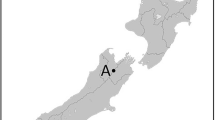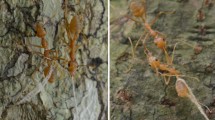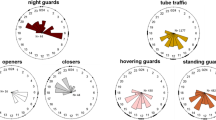Abstract
A number of studies have found that ant colonies vary in many colony-level phenotypes, including the level of aggression towards non-nestmates. The extent of a colony’s aggression and defense of the nest in response to attacks by predators is likely to affect its survival and reproduction, but the degree to which colonies vary in their defensive response is poorly known. We documented considerable variation in damage to the external nest mound of Pogonomyrmex occidentalis (Cresson) at our long-term study site in 2012. Heavily damaged colonies formed several spatial clusters, consistent with predation within a home range. We tested two competing hypotheses for the variation in nest damage: (1) colonies vary in their level of aggression, those with stronger defensive responses are better protected, and suffer less damage, versus (2) colonies have similar levels of aggression, but those that suffer predator-induced damage subsequently display a stronger defense response. We measured the alarm/aggression response in colonies exposed to a standardized stimulus and determined whether the level of aggression was correlated to the level of damage. Colonies with strong defensive responses were significantly less likely to exhibit damage than those with weak responses, suggesting that aggression level is a colony phenotype.



Similar content being viewed by others
References
Buczkowski G. and Silverman J. 2006. Geographical variation in Argentine ant aggression behaviour is mediated by environmentally derived nestmate cues. Anim. Behav. 71: 327–335
Buschinger A. and Maschwitz U. 1984. Defensive behavior and defensive mechanisms in ants. In: Defensive Mechanisms in Social Insects (Hermann H.R., Ed). Praeger Publishers, New York. pp 95–150
Chatfield C. 1984. The Analysis of Time Series, 3rd ed. Chapman and Hall, New York
Clark W.H. and Comanor P.C. 1973. The use of western harvester ant, Pogonomyrmex occidentalis (Cresson), seed stores by heteromyid rodents. Biol. Soc. Nev. Occas. Pap. 34: 1–6
Cole B.J. 1994. Nest architecture in the western harvester ant, Pogonomyrmex occidentalis (Cresson). Insect. Soc. 41: 401–410
Cole B.J. and Wiernasz D.C. 2000. Size and reproduction in the western harvester ant, Pogonomyrmex occidentalis. Insect. Soc. 47: 249–255
Crosland M.J.W. 1990. The influence of the queen, colony size and worker ovarian development on nestmate recognition in the ant Rhytidoponera confusa. Anim. Behav. 39: 413–425
Eddy T.A. 1970. Foraging behavior of the western harvester ant, Pogonomyrmex occidentalis (Hymenoptera: Formicidae) in Kansas. Ph.D. dissertation, Kansas State University
Francelino M.V., Mendonca A.A., do Nascimento R.R., de Mendonca F.C., da Silva E.L., de Freitas M.R.T., Cabral Jr C.R., da Silva C.E., Ribeiro J.H.S. and Santana A.E.G. 2008. Polyethism and nestmate recognition in the alarm reaction of Atta leaf-cutting ants. Physiol. Ecol. 33: 37–42
Hölldobler B. and Wilson E.O. 1990. The Ants. The Belknap Press of Harvard University Press, Cambridge.
Hughes W.O.H., Howse P.E. and Goulson D. 2001. Mandibular gland chemistry of grass-cutting ants: species, caste and colony variation. J. Chem. Ecol. 27: 109–124
Jandt J., Bengston S., Pinter-Wollman N., Pruitt J., Raine N., Dornhaus A. and Sih A. 2014. Behavioral syndromes and social insects: personality at multiple levels. Biol. Rev. 89: 48–67
Lavigne R.J. 1969. Bionomics and nest structure of Pogonomyrmex occidentalis (Hymenoptera: Formicidae). Ann. Entomol. Soc. Amer. 62: 1166–1175
Lubin Y.D., Montgomery G.G. and Young O.P. 1977. Food resources of anteaters (Edentata: Myrmecophagidae). I. A year’s census of arboreal nests of ants and termites on Barro Colorado Island, Panama Canal Zone. Biotropica 9: 26–34
Modlmeier A.P. and Foitzik S. 2011. Productivity increases with variation in aggression among group members in Temnothorax ants. Behav. Ecol. 22: 1026–1032
Pinter-Wollman N., Gordon D.M. and Holmes S. 2012. Nest site and weather affect the ‘personality’ of harvester ant colonies. Behav. Ecol. 23: 1022–1027
Scharf I., Pamminger T. and Foitzik S. 2011. Differential response of ant colonies to intruders: attack strategies correlate with potential threat. Ethology 117: 731–739
Scharf I., Modlmeier A.P., Fries S., Tirad C. and Foitzik S. 2012. Characterizing the collective personality of ant societies: aggressive colonies do not abandon their home. PLoS One 7: e33314 doi:10.1371/journal.pone.0033314
Schmidt J.O. and Blum M.S. 1978. A harvester ant venom: chemistry and pharmacology. Science 200: 1064–1066
Schmidt J.O. 1990. Hymenopteran venoms: Striving towards the ultimate defense against vertebrates. In: Insect Defenses: Adaptive Mechanisms and Strategies of Prey and Predators (Evans D.L. and Schmidt J.O., Eds), SUNY Press, Albany. pp 387–419
Schmidt P.J., Sherbrooke W.C. and Schmidt J.O. 1989. The detoxification of ant (Pogonomyrmex) venom by a blood factor in horned lizards (Phrynosoma). Copeia 1989: 603–607
Sturgis S.J. and Gordon D.M. 2013. Aggression is task dependent in the red harvester ant (Pogonomyrmex barbatus). Behav. Ecol. 24: 532–539
Taber S.W. 1984. World of the Harvester Ants. Texas A&M Univ Press, College Station
Tsutsui N.D., Suarez A.V. and Grosberg R.K. 2003. Genetic diversity, asymmetrical aggression, and recognition in a widespread invasive species. Proc. Natl. Acad. Sci. USA 100: 1078–1083
Wiernasz D.C. and Cole B.J. 1995. Spatial distribution of Pogonomyrmex occidentalis: recruitment, mortality and over dispersion. J. Anim. Ecol. 64: 519–527
Wiernasz D.C. and Cole B.J. 2010. Patriline shifting leads to apparent genetic caste determination in harvester ants. Proc. Natl. Acad. Sci. USA 107: 12958–12962
Wilson E.O. 1971. The Insect Societies. Belknap Press of Harvard Univ Press, Cambridge
Wray M.K., Mattila H.R. and Seeley T.D. 2011. Collective personalities in honeybee colonies are linked to colony fitness. Anim. Behav. 81: 559–568
Acknowledgments
We thank Lara Appleby, Drew Russey, and two anonymous reviewers for comments on an earlier version of the manuscript. We thank the Bureau of Land Management for protection of the harvester ant study area. Our long-term study of P. occidentalis, which provides the context for this work, has been supported by National Science Foundation Grants IOS-0344896 and IOS-1147418 to BJC and DCW.
Author information
Authors and Affiliations
Corresponding author
Rights and permissions
About this article
Cite this article
Wiernasz, D.C., Cole, B.A. & Cole, B.J. Defending the nest: variation in the alarm aggression response and nest mound damage in the harvester ant Pogonomyrmex occidentalis . Insect. Soc. 61, 273–279 (2014). https://doi.org/10.1007/s00040-014-0352-8
Received:
Revised:
Accepted:
Published:
Issue Date:
DOI: https://doi.org/10.1007/s00040-014-0352-8




